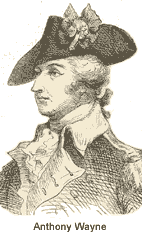Not all of President Washington's problems were confined to creating the mechanisms of a new government or establishing a place for the young republic among the world's powers. An immediate threat existed on the western frontier, which at that time was the Ohio country. With independence secured from Britain, many Americans wanted to push into the alluring western lands, but were wary because of a growing confederation among the native tribes of the region.
Two major military setbacks made the American settlers cautious when considering westward expansion:
In the fall of 1790, Harmar and a combined force of regular army and volunteers moved northward to quell the threat from the Miami and their allies. In October, the American army was ambushed and thoroughly routed by Little Turtle, on the banks of the Maumee River. This defeat was regarded as a great humiliation for the young nation. Harmar retired shortly thereafter.
 At this point, Washington turned to General "Mad Anthony" Wayne, a man with a truly distinguished record of service in the Revolutionary War. He had fought with Benedict Arnold in the Quebec campaign, stormed Stony Point in New York (earning the name "Mad Anthony" for his bravery), narrowly averted disaster at the hand of Cornwallis in Virginia, and was in the thick of extremely bitter fighting in South Carolina and Georgia, in 1782. The President recalled him to active service in 1792.
At this point, Washington turned to General "Mad Anthony" Wayne, a man with a truly distinguished record of service in the Revolutionary War. He had fought with Benedict Arnold in the Quebec campaign, stormed Stony Point in New York (earning the name "Mad Anthony" for his bravery), narrowly averted disaster at the hand of Cornwallis in Virginia, and was in the thick of extremely bitter fighting in South Carolina and Georgia, in 1782. The President recalled him to active service in 1792.Wayne devoted months to the thorough training of his soldiers. This careful preparation was noted by Little Turtle, who recommended to his confederates that a peace agreement be sought. Blue Jacket, a Shawnee, opposed that suggestion and emerged as the war leader of the confederacy. In July 1794, Wayne's army moved out of Greenville (present-day western Ohio near the Indiana border), a force of 2,000 regulars, known as the Legion of the United States, and 1,500 volunteers.
The encounter took place on August 20, in an area where a recent storm had brought down many trees, hence the name "fallen timbers." The native confederacy numbered in excess of 1,000 and was composed of Shawnee, Mingo, Delaware, Wyandot, Miami, Ottawa, Chippewa, and Pottawatomie warriors.
The U.S. forces used their superior numbers and arms to advantage, forcing a disorganized retreat on the Native Americans. The fleeing tribes sought refuge with the British at Fort Miami, but the gates there remained closed.
U.S. losses at Fallen Timbers amounted to 30 killed and about 100 wounded. Native losses were difficult to determine because of their practice of quickly removing their casualties from the field. Estimates of 200 killed and 400-500 wounded are commonly accepted.
Although some resistance continued into the following year, a large measure of peace was secured in 1795 in the conclusion of the Treaty of Greenville, the direct result of the American victory at Fallen Timbers.
The exact location of the battle was the subject of speculation until 1995 when Professor G. Michael Pratt of Heidelberg College determined that it was about a quarter mile from the previously accepted location. 187 acres considered to be a key portion of the battlefield site was acquired by Metroparks of the Toledo area.